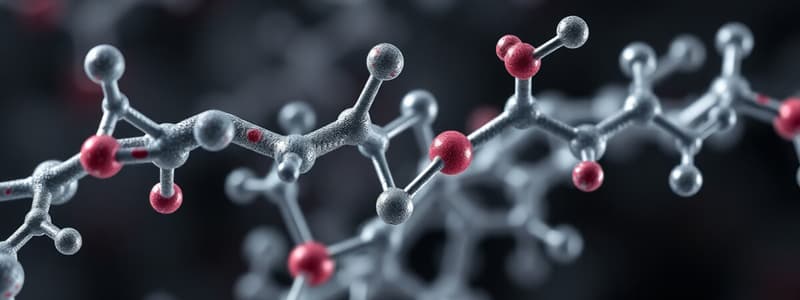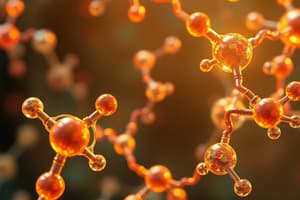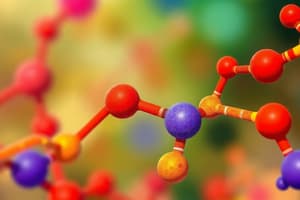Podcast
Questions and Answers
What process occurs when two monomers bond together with the loss of a water molecule?
What process occurs when two monomers bond together with the loss of a water molecule?
- Condensation reaction (correct)
- Ionization reaction
- Hydrolysis reaction
- Dehydration reaction (correct)
Which of the following biological molecules is not a polymer?
Which of the following biological molecules is not a polymer?
- Proteins
- Lipids (correct)
- Carbohydrates
- Nucleic acids
What role do enzymes play in the process of dehydration reactions?
What role do enzymes play in the process of dehydration reactions?
- They break down polymers into monomers.
- They slow down the reaction rate.
- They speed up the reaction process. (correct)
- They stabilize the water molecule produced.
What is the result of hydrolysis on a polymer?
What is the result of hydrolysis on a polymer?
How do the diversity of macromolecules differ within an organism?
How do the diversity of macromolecules differ within an organism?
What is the primary role of nucleic acids in living organisms?
What is the primary role of nucleic acids in living organisms?
Which statement best describes monomers in relation to macromolecules?
Which statement best describes monomers in relation to macromolecules?
What process essentially reverses a dehydration reaction?
What process essentially reverses a dehydration reaction?
Which class of macromolecules primarily dictates the amino acid sequence of polypeptides?
Which class of macromolecules primarily dictates the amino acid sequence of polypeptides?
What is a characteristic shared by carbohydrates, proteins, and nucleic acids?
What is a characteristic shared by carbohydrates, proteins, and nucleic acids?
What is the primary function of DNA in a cell?
What is the primary function of DNA in a cell?
Which of the following nitrogenous bases is not found in DNA?
Which of the following nitrogenous bases is not found in DNA?
Which component of a nucleotide distinguishes RNA from DNA?
Which component of a nucleotide distinguishes RNA from DNA?
What process occurs in the ribosomes?
What process occurs in the ribosomes?
What is the structure that consists of a nitrogenous base attached to a sugar called?
What is the structure that consists of a nitrogenous base attached to a sugar called?
Which nitrogenous bases are classified as purines?
Which nitrogenous bases are classified as purines?
What sequence correctly describes the flow of genetic information?
What sequence correctly describes the flow of genetic information?
Which part of a nucleotide is absent in the structure of a nucleoside?
Which part of a nucleotide is absent in the structure of a nucleoside?
Which of the following correctly describes the term 'polynucleotide'?
Which of the following correctly describes the term 'polynucleotide'?
Where does the synthesis of mRNA occur within a eukaryotic cell?
Where does the synthesis of mRNA occur within a eukaryotic cell?
What type of bonds join adjacent nucleotides in a DNA or mRNA polymer?
What type of bonds join adjacent nucleotides in a DNA or mRNA polymer?
In the context of DNA structure, what does the term 'antiparallel' refer to?
In the context of DNA structure, what does the term 'antiparallel' refer to?
Which of the following correctly matches the nitrogenous bases in DNA?
Which of the following correctly matches the nitrogenous bases in DNA?
What does the sequence of bases along a DNA or mRNA polymer indicate?
What does the sequence of bases along a DNA or mRNA polymer indicate?
Which carbon atoms are involved in the formation of the covalent bond between adjacent nucleotides?
Which carbon atoms are involved in the formation of the covalent bond between adjacent nucleotides?
What structural feature of DNA is critical for its function?
What structural feature of DNA is critical for its function?
How many strands make up a DNA molecule?
How many strands make up a DNA molecule?
What is formed when nitrogenous bases pair up in DNA?
What is formed when nitrogenous bases pair up in DNA?
The backbone of a DNA molecule consists of which parts?
The backbone of a DNA molecule consists of which parts?
What happens to the polarity of the DNA strands?
What happens to the polarity of the DNA strands?
Flashcards
Macromolecule
Macromolecule
A large molecule composed of thousands of covalently bonded atoms.
Polymer
Polymer
A long molecule consisting of many similar building blocks.
Monomer
Monomer
The small building-block molecules that make up a polymer.
Dehydration reaction
Dehydration reaction
Signup and view all the flashcards
Hydrolysis
Hydrolysis
Signup and view all the flashcards
Enzyme
Enzyme
Signup and view all the flashcards
Carbohydrates
Carbohydrates
Signup and view all the flashcards
Proteins
Proteins
Signup and view all the flashcards
Nucleic acids
Nucleic acids
Signup and view all the flashcards
Gene
Gene
Signup and view all the flashcards
Nucleic Acids
Nucleic Acids
Signup and view all the flashcards
DNA
DNA
Signup and view all the flashcards
RNA
RNA
Signup and view all the flashcards
Nucleotide
Nucleotide
Signup and view all the flashcards
Nucleoside
Nucleoside
Signup and view all the flashcards
Nitrogenous bases
Nitrogenous bases
Signup and view all the flashcards
Pyrimidine
Pyrimidine
Signup and view all the flashcards
Purine
Purine
Signup and view all the flashcards
Polynucleotide
Polynucleotide
Signup and view all the flashcards
Protein synthesis
Protein synthesis
Signup and view all the flashcards
Nucleotide bond
Nucleotide bond
Signup and view all the flashcards
Sugar-Phosphate Backbone
Sugar-Phosphate Backbone
Signup and view all the flashcards
Base Sequence
Base Sequence
Signup and view all the flashcards
DNA Double Helix
DNA Double Helix
Signup and view all the flashcards
Antiparallel Strands
Antiparallel Strands
Signup and view all the flashcards
Base Pairing
Base Pairing
Signup and view all the flashcards
5' and 3' ends
5' and 3' ends
Signup and view all the flashcards
Hydrogen bonds
Hydrogen bonds
Signup and view all the flashcards
Gene
Gene
Signup and view all the flashcards
Polynucleotide
Polynucleotide
Signup and view all the flashcards
Study Notes
Chapter 5: The Structure and Function of Large Biological Molecules
- Living organisms are composed of four main types of large biological molecules: carbohydrates, lipids, proteins, and nucleic acids.
- Small organic molecules combine to form larger molecules within cells.
- Macromolecules are large molecules formed from thousands of covalently linked atoms.
- Molecular structure and function are interdependent.
Concept 5.1: Macromolecules are Polymers, Built from Monomers
- A polymer is a long molecule made up of similar building blocks.
- Monomers are the small building-block molecules that form polymers.
- Carbohydrates, proteins, and nucleic acids are examples of polymers.
The Synthesis and Breakdown of Polymers
- Dehydration reactions join monomers together; a water molecule is removed.
- Enzymes facilitate dehydration reactions.
- Polymers are broken down into monomers through hydrolysis, which is the reverse of dehydration.
The Diversity of Polymers
- Cells contain thousands of diverse macromolecules.
- Macromolecules vary among cells within the same species and even more between species.
- A diverse range of polymers can be made using a limited number of monomers.
Concept 5.5: Nucleic Acids Store and Transmit Hereditary Information
- The amino acid sequence of a polypeptide is determined by a gene, a unit of inheritance.
- Genes are made of DNA, a nucleic acid.
The Roles of Nucleic Acids
- Two types of nucleic acids: DNA and RNA.
- DNA directs its own replication and the synthesis of mRNA.
- mRNA guides protein synthesis, which occurs in ribosomes.
The Structure of Nucleic Acids
- Nucleic acids are polymers called polynucleotides.
- Polynucleotides are formed from monomers called nucleotides.
- Each nucleotide comprises a nitrogenous base, a pentose sugar, and a phosphate group.
- A nucleoside is a nucleotide without the phosphate group.
Nucleotide Monomers
- A nucleoside is a nitrogenous base plus a sugar.
- Two families of nitrogenous bases: pyrimidines (single ring) and purines (double ring).
- DNA has deoxyribose; RNA has ribose.
- Nucleotide = nucleoside + phosphate group
Nucleotide Polymers
- Nucleotides are linked to form polynucleotides.
- Adjacent nucleotides are joined by covalent bonds between the 3' carbon of one nucleotide and the 5' carbon of the next.
- This creates a sugar-phosphate backbone with nitrogenous bases as appendages.
- The sequence of bases is unique to each gene.
The DNA Double Helix
- DNA consists of two polynucleotide strands that spiral around a central axis to form a double helix.
- The two strands run in opposite directions (antiparallel).
- Nitrogenous bases pair up via hydrogen bonds (A with T, and G with C).
Studying That Suits You
Use AI to generate personalized quizzes and flashcards to suit your learning preferences.




